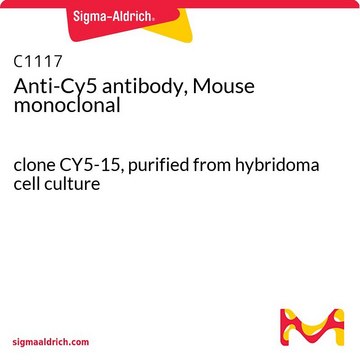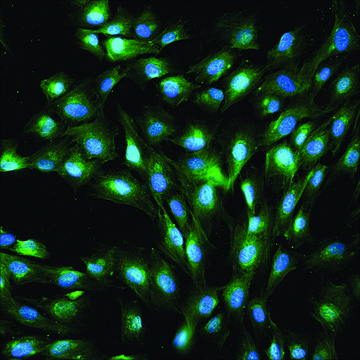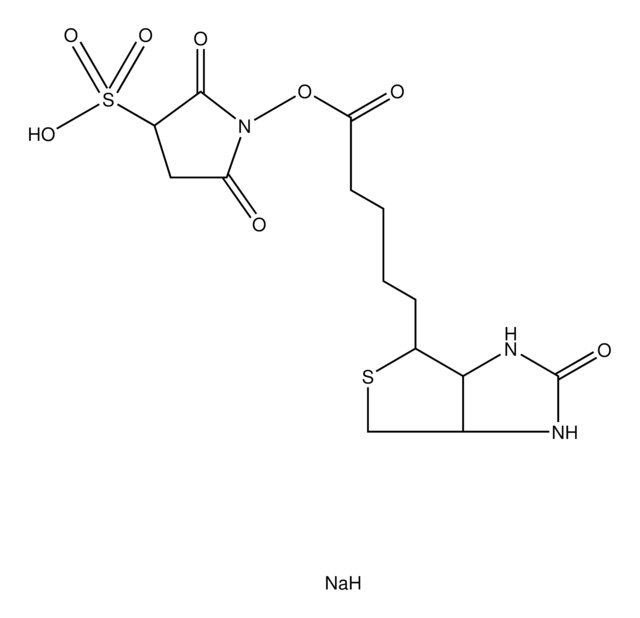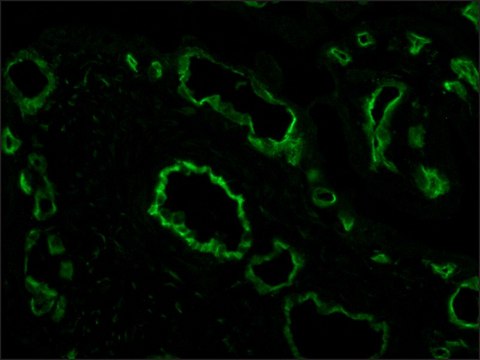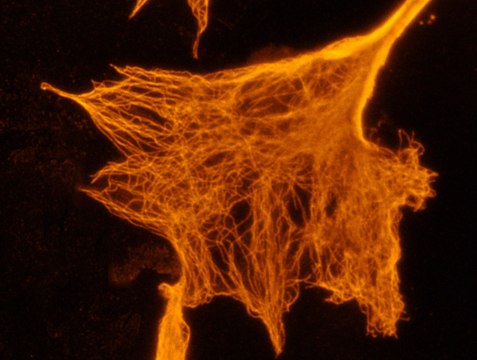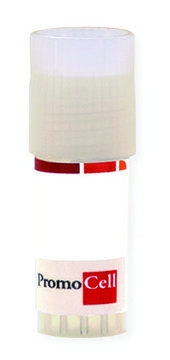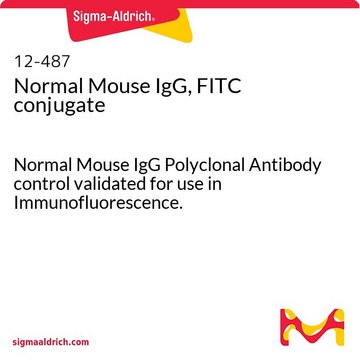推荐产品
生物来源
mouse
质量水平
偶联物
unconjugated
抗体形式
purified from hybridoma cell culture
抗体产品类型
primary antibodies
克隆
CY-96, monoclonal
表单
buffered aqueous solution
浓度
~1.5 mg/mL
技术
direct ELISA: suitable
dot blot: 1-2 μg/mL using cell protein extracts labeded with Cy3 or Cy5
immunocytochemistry: suitable
immunoprecipitation (IP): suitable
microarray: suitable
同位素/亚型
IgG2a
运输
dry ice
储存温度
−20°C
靶向翻译后修饰
unmodified
正在寻找类似产品? 访问 产品对比指南
一般描述
Anti-Cy3/Cy5 antibody, Mouse monoclonal, (mouse IgG2a isotype) is derived from the hybridoma CY-96 produced by the fusion of mouse myeloma cells (NS1 cells) and splenocytes from Balb/c mice immunized with a mixture of proteins labeled with Cy3 or Cy5.
特异性
The antibody recognizes Cy3 and Cy5 conjugated to proteins.
免疫原
mixture of proteins labeled with Cy3/Cy5.
应用
Anti-Cy3/Cy5 antibody, Mouse monoclonal has been used in:
- immunofluorescence
- western blot
- dot blot
- enzyme linked immunosorbent assay (ELISA)
- immunoprecipitation
- immunocytochemistry
- protein microarrays
- In in situ hybridization
Applications in which this antibody has been used successfully, and the associated peer-reviewed papers, are given below.
Immunofluorescence (1 paper)
Immunofluorescence (1 paper)
生化/生理作用
Cy 3 and Cy5 are the most popular cyanine dyes, used combined for two color detection. Cy3 dyes are fluorescent orange while Cy5 is fluorescent in the red region. Cyanine belonging to polymethine group. CyDyes are a family of fluorophores that can be used for labeling proteins, peptides, DNA, RNA, and other biomolecules. These dyes are small, pH insensitive, soluble in aqueous solution and are tolerant to DMSO. They are more photostable than fluorescein, have high molar extinction coefficients and favorable quantum yields. Mainly Cy3 and Cy5 are used in many different biological assays such as DNA microarrays, protein microarrays, two-dimensional protein analysis (2D gels), fluorescence resonance energy transfer (FRET), and immunocytochemistry.
外形
0.01M 磷酸缓冲盐溶液,pH 7.4,含 15mM 叠氮化钠。
免责声明
Unless otherwise stated in our catalog or other company documentation accompanying the product(s), our products are intended for research use only and are not to be used for any other purpose, which includes but is not limited to, unauthorized commercial uses, in vitro diagnostic uses, ex vivo or in vivo therapeutic uses or any type of consumption or application to humans or animals.
未找到合适的产品?
试试我们的产品选型工具.
储存分类代码
10 - Combustible liquids
WGK
WGK 3
闪点(°F)
Not applicable
闪点(°C)
Not applicable
个人防护装备
Eyeshields, Gloves, multi-purpose combination respirator cartridge (US)
法规信息
常规特殊物品
历史批次信息供参考:
分析证书(COA)
Lot/Batch Number
A K Kenworthy
Methods (San Diego, Calif.), 24(3), 289-296 (2001-06-14)
Fluorescence resonance energy transfer (FRET) detects the proximity of fluorescently labeled molecules over distances >100 A. When performed in a fluorescence microscope, FRET can be used to map protein-protein interactions in vivo. We here describe a FRET microscopy method that
Wonbae Lee et al.
Nucleic acids research, 42(9), 5967-5977 (2014-03-15)
DNA constructs labeled with cyanine fluorescent dyes are important substrates for single-molecule (sm) studies of the functional activity of protein-DNA complexes. We previously studied the local DNA backbone fluctuations of replication fork and primer-template DNA constructs labeled with Cy3/Cy5 donor-acceptor
Te Liu et al.
Molecular medicine reports, 13(6), 5053-5058 (2016-04-29)
Premature ovarian failure (POF) is a common cause of female infertility, for which there are currently no ideal treatments or medications. Furthermore, apoptosis of ovarian granulosa cells (OGCs) is an important mechanism underlying the decline in ovarian reserve and function.
Myosin-Va mediates RNA distribution in primary fibroblasts from multiple organs
Salerno V P, et al.
Cell Motility and the Cytoskeleton, 65(5), 422-433 (2008)
Pier Giorgio Righetti et al.
European journal of mass spectrometry (Chichester, England), 10(3), 335-348 (2004-06-10)
The present review attempts to cover the vast array of methods which have appeared in the last few years for performing quantitative proteome analysis. These methods are divided into two classes: those applicable to conventional two-dimensional map analysis, coupling orthogonally
我们的科学家团队拥有各种研究领域经验,包括生命科学、材料科学、化学合成、色谱、分析及许多其他领域.
联系技术服务部门
